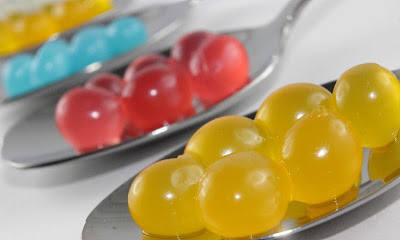Exceptional food that worth a special journey. And all other foods that can kill you.
Friday
A Practical Temperature Guide to Sous Vide Cooking
1) The minimum acceptable sous vide cooking temperature is 55°C for all meats, except poultry for which the minimum acceptable sous vide cooking temperature is 60°C.
2) Heating to a higher end point temperature increases toughness of meats.
3) The sous vide process is not simply vacuum packing and then cooking at a relatively low temperature but also requires recipe modification like the sauce.
4) Sous vide cooking below 55°C must not exceed a period of 4 hours. Foods held at temperatures below 55°C for longer than 4 hours must be discarded.
5) Increased risk of food poisoning if sous vide packs are subjected to temperature abuse. Temperature-abuse temperature conditions is (12 ± 1C).
Get it NOW, Accurate Sous Vide Cooking Times- PDF Free Download
6) Internal digital probe tip thermometers accurate to ±0.1°C must be used to monitor temperatures.
7) How to take the temperature of foods. Just use a needle type probe tip--- digital thermometer. Apply a piece of cell foam tape to the sous vide pouch where the probe thermometer will be inserted. This will prevent the vacuum from being lost in the pouch, and prevent any leakage when the probe thermometer is inserted and removed. Stick the thermometer into the interior of the food at its thickest point.
8) Cooking times can vary considerably. A thin cut of fish may cook in a short period of time, in only a few minutes. Some otherwise tough cuts of meat, for example beef brisket and short ribs, benefit greatly from very long (48 to 72 hours) sous vide heating at medium-rare temperatures of around 55°C (131 F). You can also braise tougher meats like duck leg or lamb shank at 82°C for 8 hours or at 75°C for 12 hours. Cooking the meats in this way also helps to keep the color of the meat.
9) What is come up time (CUT)? This is the period of time it will take for food to reach a specific internal core temperature. This is similar to waiting for a conventional oven to come up and equilibrate to a specific temperature. Settings on the sous vide immersion circulator are recommended to be set at least one degree higher than the desired internal core temperature of the food.
Once the internal temperature of the food has come up to the desired target, it must be held for another period of time that will be equivalent to a 6.5-log10 to 7-log10 reduction of bacteria to achieve a full pasteurization. The CUT will depend on the size (thickness) of the food, the initial temperature of the food, and the amount of food placed at one time in the equipment. CUT is also known as the time for foods to reach temperature equilibrium with the water.
10) Parasites, in sea foods intended to be used in sous vide cooking or served raw, can be eliminated by pre-freezing food at a specific temperature and time. Viruses and bacteria are not eliminated by freezing. Viruses can also be more difficult to remove using heat, as they may take a higher and longer heating period to destroy.
Related Blog Post: Do you like to master the art and science of Sous Vide cooking technique and be a Sous Vide Master Chef, and then you should get the 9 Best Cookbooks for Sous Vide Cooking Technique. NOW!
References:
Baldwin, Douglas. 2010. Sous Vide for the Home Cook Cookbook. Sous Vide. ISBN-13: 978-0984493609
Christensen L, Gunvig A, Tørngren MA, Aaslyng MD, Knøchel S, and Christensen M. 2012. Sensory characteristics of meat cooked for prolonged times at low temperature. Meat Science.
Culinary Institute of America, The. 2011. Sous Vide, The Professional Chef. Hoboken, New Jersey: John Wiley & Sons, Inc.; p. 548-52. ISBN-13: 978-0470421352
Keller Thomas, Benno J, Lee C, and Rouxel S. 2008. Under Pressure: Cooking Sous Vide. New York: Artisan / Workman Publishing Company. ISBN-13: 978-1579653514
Logsdon, Jason 2010. Beginning Sous Vide: Low Temperature Recipes and Techniques for Getting Started at Home. CreateSpace Independent Publishing Platform. ISBN-13: 978-1456336974
Myhrvold, Nathan and Bilet M. 2012. Cooking Sous Vide, Modernist Cuisine at Home. 1st ed. Bellevue, WA: The Cooking Lab, LLC. ISBN-13: 978-0982761014
Subscribe to:
Post Comments (Atom)


No comments:
Post a Comment